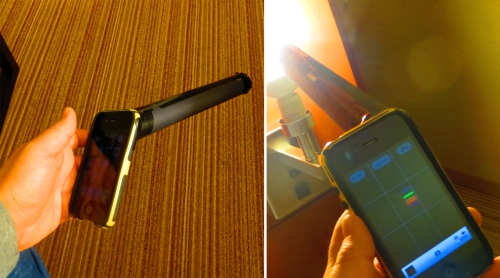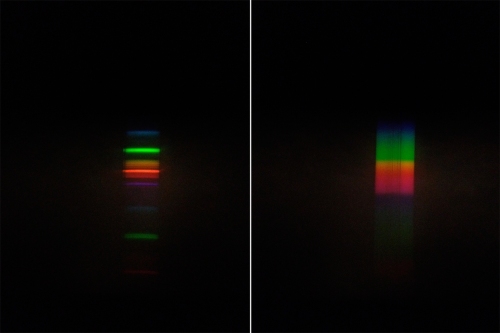by Shane L. Larson
The other morning, when she was trying to decide what to wear for the day, my daughter said to me, “Is it cold outside?” Then, without missing a beat, she says “Never mind,” and picked up an iPhone and checked the current weather conditions. This brought to mind a vivid memory from my childhood of me asking the same question of my mother, and her saying “Go out and check!” She had a rock on her porch; if it was wet it was raining, if it was white it was snowing, if it was hard to see it was foggy, and so on.
Far be it from me to eschew modern technology; it can do awesome things! But it strikes me that if there is any truth about modern society, it is that it is entirely possible to live your life looking through the electronic portal of digital technology, rather than by looking out the window.

My schedule is kept by a modern calendar application, accessible from my phone. This is modern progress. Sigh.
This was not always the case, of course. Our forebears had to pay attention to the world, literally because it was a matter of life and death. Today, if strawberries are out of season in the northern US, no worries — your local store is shipping you some from far away, the cogs of the modern economy meeting your every whim. But hundreds and thousands of years ago, crops had to be planted in time for the life giving rains, and harvest had to be brought in before fall frosts destroyed the yields that had to last through the winter. Before quartz watches, before Greenwich Mean Time, and before Google Calendar, people still had to know what time of year it was.
So what did people do before the world worked on linked times and calendars? They watched the sky! The sky is filled with a regular clockwork of motions that ticks off the seconds, days, and aeons as precisely and regularly as the finest timepiece humans have ever made. The motions in the sky are a combination of the Earth’s orbital motion around the Sun, the spin of the Earth on its axis, and the fact that the North Pole of the Earth is not pointing straight up from the orbit.
One observational consequence of these three facts is that the Sun’s position in the sky changes over the course of a year. Each day it rises and sets at a different point on the horizon, and it tracks across the sky along a different pathway. The equinoxes are the days during the year when the Sun rises and sets directly in the East and West. The solstices are the days during the year when the Sun rises and sets at the point furthest North and South on the horizon.
The ever-changing rise and set position of the Sun along the horizon can be used as a calendar. One of the most famous examples is the Shungopavi horizon calendar of the Hopi in the American southwest, shown below. As the sunrise marches north and south along the horizon, its passage by certain landmarks indicates times of planting, harvest, and cultural ceremonies. While you likely have no need for a horizon calendar, it can be fun to construct one via sunrise observations at your own home, like mine in Paradise, Utah, also shown below.

Example horizon calendars. The Hopi Shungopavi horizon calendar (top), and my personal horizon calendar for Paradise, Utah (bottom).
There are many ancient sites around the world where the rising and setting of the stars and Sun are aligned over carefully placed stones and architectural structures. Stonehenge on the verdant Salisbury Plain, and the great Anasazi kiva Casa Rinconada in Chaco Canyon, and the Great Medicine Wheel on top of Wyoming’s Bighorn Range. All of these sites, and many more besides, bespeak of the intimate knowledge our ancient ancestors had about the sky.

Ancient astronomically aligned sites. (L) Stonehenge, (C) Casa Rinconada, (R) Bighorn Medicine Wheel.
Sometimes modern landscapes align with the celestial clockwork, possibly by design but often by accident. Consider the island of Manhattan. The island sits in the mouth of the Hudson River, canted diagonally to the north-south direction. When it was first settled, the streets were laid out willy-nilly, in the usual haphazard organic way of ancient cities. The expanding maze of twisty little streets that all look the same was abruptly ended by the Commissioners’ Plan of 1811, which established a grid plan for the growth of the city. The grid was laid out with the long northish-southish thoroughfares running parallel to the coastline of the island. As a consequence, the cross-streets running eastish-westish are all canted roughly 25 to 30 degrees to the east-west direction. As it turns out, that is just the right tip for all the streets to be close to lining up with the sunrise and sunset directions on the Summer Solstice! This was famously noted about ten years ago by Neil deGrasse Tyson, who dubbed the phenomenon “Manhattanhenge.”

The street grids for Manhattan (L) and for Chicago (R). The geometry of the streets determines when you will have a well placed sunrise or sunset to make a cityhenge.
But you don’t have to travel all the way to Manhattan to enjoy modern astronomical alignments. Many towns and cities are laid out on a grid system. For grids lined up on a north-south and east-west system, magic happens every March and every September, on the equinoxes. For instance, in the city of Chicago, the streets are laid out (more or less) on a rectangular grid aligned to the compass points, and a “Chicagohenge” can be photographed on the Spring Equinox in March, and on the Fall Equinox in September!
![Examples of Chicagohenge [Images from Ken Ilio's Uncommon Photographers].](https://writescience.files.wordpress.com/2013/03/chicagohenge.jpg?w=500&h=166)
Examples of Chicagohenge [Images from Ken Ilio’s Uncommon Photographers].
![(L) The street grid in Vankleek Hill, Ontario is canted about 20 degrees to an east-west line. (R) A summer solstice along Vankleek Hill's streets [image by Gabriel Landriault].](https://writescience.files.wordpress.com/2013/03/vankleekhill.jpg?w=500&h=187)
(L) The street grid in Vankleek Hill, Ontario is canted about 20 degrees to an east-west line. (R) A summer solstice along Vankleek Hill’s streets [image by Gabriel Landriault].

An example simulation of sunrise and sunset from the Adler Planetarium on the Spring Equniox, using StarryNight desktop planetarium software.
The truth is, it is not a life and death matter if I don’t pay attention to the daily motion of the Sun and use that information to lead a subsistence, agrarian lifestyle. I have a calendar, the Farmer’s Almanac, and Google to tell me when to plant my snap peas. I can really just do astronomy for fun — because it is cool, and it lets me capture some beautiful pictures that I can use to impress my friends and woo members of the opposite sex.
The Spring Equinox is just around the corner! So go out with your cell phone and catch a sunrise or a sunset, directly down your nearest East-West street. Make sure you tweet the picture to the rest of us, so we know it is spring and can start to think about planting our gardens; strawberry season is on its way!







![(L) Magnetometer reading as I push my tricorder toward the power cord to my laptop [which is SO Twentieth Century!] Video here. (R) Magnetometer reading as I move my tricorder around the back of my flat screen TV. What is in there? Video here.](https://writescience.files.wordpress.com/2013/02/magnetometers.jpg?w=500&h=212)















